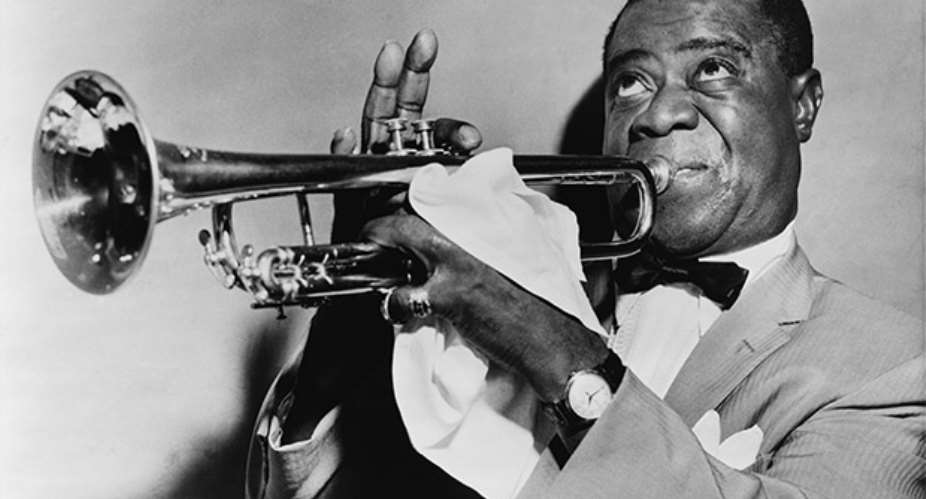In 1956, the people of the Gold Coast hosted the legendary black trumpeter, composer and sometimes actor Louis Armstrong aka Satchmo. It was an important opportunity for the people of this country then under the yoke of colonialism to see a man who traced his ancestry to this part of the world.
The Gold Coast was one of the slave trading locations in West Africa and so the conjecture, if you like, that many African-Americans originated from here cannot be faulted.
When he landed here, the moments were consumed by the indigenes – many of who knew the history of how indigenes of the Gold Coast were sold into slavery.
The musician came for the programme with his band and thrilled his hosts at various programmes lined up for him including a filming session.
One significant feature of his visit was when he saw a Gold Coast woman dancing; a scene which he said reminded him of his mother who the indigenous woman resembled. The scene was inspiring as it was nostalgic.
The nostalgia was so powerful that he rendered it in his own handwriting as reproduced here on this page.
The material is sourced from a 1956 edition of the Daily Graphic and oral tradition. I have had the rare privilege of being given a Daily Graphic press cutting of the 1950s, a trove of history: portions of which I intend re-presenting periodically as I blend it with oral tradition where possible.
Louis Armstrong had a nice time in Accra playing with local highlife maestro ET Mensah. At a joint session, Louis watched ET Mensah on the trumpet and could not help remarking “that boy sure plays lot of trumpet.”
The two musicians both played at Paramount Club in Accra. The programme was filmed by one of the world's leading broadcasting systems, the Colombia Broadcasting System's Television Unit.
ET Mensah was playing for the first time in front of the world's best trumpeter and many wondered how he was going to manage the complex. He scaled through with ease. It was remarked by a Daily Graphic reporter who covered the 1956 event thus “he did not let the Gold Coast down”.
Louis Armstrong played St. Louis Blues for the film which the unit captured. He played thrice but the crew asked him to do it once more so a little boy dancing on top of a roof could enjoy the rhythm.
Louis went beneath the roof and played what the reporter described as an endless stream of music and attracted deserved applause. The TV crew was not satisfied and demanded a repeat for their cameras. It was a hectic session.
Louis Armstrong had another session at the Opera Cinema; one of the many now non-functioning cinema houses in Accra. In those days, it was one of the hottest entertainment hubs in Accra.
Many spectators turned up for the session, most if not all, hearing jazz for the first time in their lives.
Louis Armstrong had an affinity for the Gold Coast because he had reason to believe that it was his ancestral home. He promised to visit the country at least once a year.
At the end of the visit he wrote “Well folks here's saying so long for now, but since I saw one of the women dancing in one of the tribes yesterday who looked just like my mother Mary Ann, who died in 1927, I'll just have to return to my homeland to blow for the cats at least once a year- yeah Love.”
Louis Satchmo Armstrong who was born on August 4, 1901 in New Orleans, Louisiana, US in a poor section of the city endured a tough upbringing.
Things were so tough for the father, a factory worker, that he abandoned the little boy and his mother who had to turn to prostitution to sustain the family.
A Jewish family brought him up eventually with whom he had joint meals – an unusual gesture at that time in history. He got into trouble on New Year's Eve in 1912 when he fired his stepfather's gun into the air. He was confined to a Coloured Home for Boys where he received music lessons on the coronet and thereafter fell in love with music.
He became a jazz legend releasing world classics such as What A Wonderful World, La Vie En Rose, When The Saints Go Marching On.
With his distinctive baritone, there is no mistaking the jazz maestro and the people of Gold Coast at the time relished his performance when they had that rare opportunity.
By A.R. Gomda





 Akufo-Addo commissions Phase II of Kaleo solar power plant
Akufo-Addo commissions Phase II of Kaleo solar power plant
 NDC panics over Bawumia’s visit to Pope Francis
NDC panics over Bawumia’s visit to Pope Francis
 EC blasts Mahama over “false” claims on recruitment of Returning Officers
EC blasts Mahama over “false” claims on recruitment of Returning Officers
 Lands Minister gives ultimatum to Future Global Resources to revamp Prestea/Bogo...
Lands Minister gives ultimatum to Future Global Resources to revamp Prestea/Bogo...
 Wa Naa appeals to Akufo-Addo to audit state lands in Wa
Wa Naa appeals to Akufo-Addo to audit state lands in Wa
 Prof Opoku-Agyemang misunderstood Bawumia’s ‘driver mate’ analogy – Miracles Abo...
Prof Opoku-Agyemang misunderstood Bawumia’s ‘driver mate’ analogy – Miracles Abo...
 EU confident Ghana will not sign Anti-LGBTQI Bill
EU confident Ghana will not sign Anti-LGBTQI Bill
 Suspend implementation of Planting for Food and Jobs for 2024 - Stakeholders
Suspend implementation of Planting for Food and Jobs for 2024 - Stakeholders
 Tema West Municipal Assembly gets Ghana's First Female Aircraft Marshaller as ne...
Tema West Municipal Assembly gets Ghana's First Female Aircraft Marshaller as ne...
 Dumsor is affecting us double, release timetable – Disability Federation to ECG
Dumsor is affecting us double, release timetable – Disability Federation to ECG
